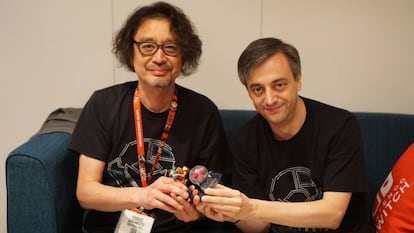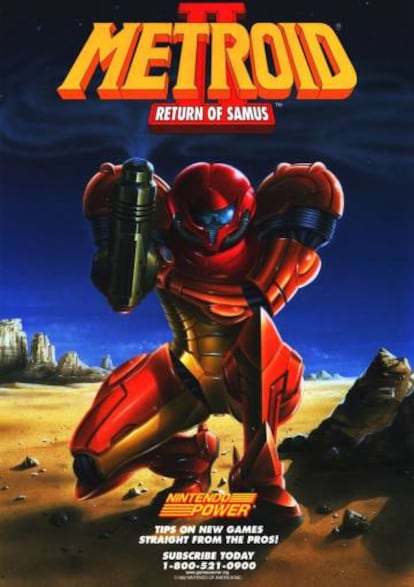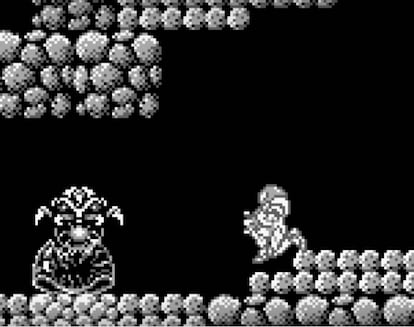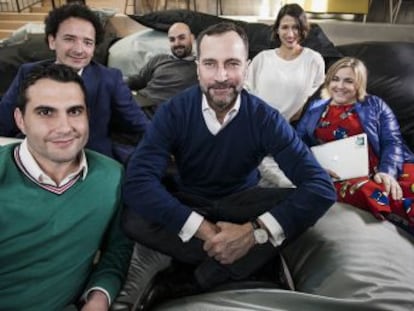Legendary Nintendo developer looks to Spaniard for help with new game
Yoshio Sakamoto has chosen Spanish studio MercurySteam to design latest version of ‘Metroid’

José Luis Márquez is living in a dream he still cannot believe is real. He pinches himself often, as he was doing a few days ago in Los Angeles, at the center of the media hurricane known as E3, where the best of videogames are celebrated with pomp and circumstance. With the sting of each pinch, he comes to recognize that the dream “ought to be real.” But still, he is not convinced. For he has completed the greatest desire of his entire life: to design a game for one of Nintendo’s most celebrated franchises: Metroid.
Metroid was one of the first console games oriented towards an adult audience. While Super Mario was jumping from platform to platform capturing coins, Yoshio Sakamoto was offering – in 1986 – a work inspired by Ridley Scott’s Alien, centered upon the anxieties of exploring an extraterrestrial land. Similar to Scott’s series, the protagonist of these games is female – known to fanatics across the world as Samus – and her primary task involves battling an enemy species called metroids.
The telling of the story is enhanced by a rich interactive experience, including costumes, scenery and character reactions – features that made the game far ahead of its time.

Today the task of continuing Sakamoto’s vision now rests squarely on the shoulders of Márquez and his team at Madrid-based MercurySteam. The group of 130 developers, which has already seen remarkable success in its work on Japanese firm Konami’s Castlevania franchise, has now become the first European collaborator to develop a prominent series for Nintendo. They have done it over the course of two years – in silence and under the strict supervision of Sakamoto, who is famed for being extremely protective of his universe.
Sitting on a sofa, Sakamoto and Márquez are smiling during an exclusive interview granted to EL PAÍS. They say that they have worked so closely together in collaboration, their partnership feels more like a friendship. Sakamoto laughs frequently, and on more occasions than one, puts his hand on Márquez’s back, exclaiming: “Arigato, Arigato!” Thank you, in Japanese. Because Sakamoto, too, is fulfilling a dream of his own with this game: a remake of Metroid II, which utilizes all of today’s resources and which will be released on the Nintendo 3DS – the most popular portable console of the current generation, with more than 65 million units sold. He chose to do a remake of the series’ second installment because he was not a part of the team that designed the original version. While he respects their work, he hopes to make this newer edition his own and align it better with the rest of the saga.
And what was the role of the Spaniards at MercurySteam in Sakamoto’s vision? Of course, they were not mere craftsmen, slaving away at his behest.

“I felt like working with a new team that had fresh ideas. Mercury has them. In fact, the majority of the new additions are theirs. I charged myself with preserving the legacy, the fundamental keys that make a game like Metroid genuine,” explained the Japanese designer.
The new features offered by Márquez are focused on the design of the game’s interactions – enhancements to how one engages in combat or explores the alien scenery. The system of counterattacks, which completely changes the nature of action in the game, is one of the innovations integrated by the Spanish team into the reboot. “It makes things more exciting and gives a new urgency to the combat, especially when fighting against a metroid. Moreover, the sequence that is activated upon executing an effective counterattack is totally interactive. You can choose the type of attack in the middle of the cinematographic mini-sequence,” Márquez says.
My father was not sold on videogames. Now, he cries with pride for his son MercurySteam designer José Luis Márquez
Sakamoto has a rather peculiar assessment of the Spanish designers when asked how he saw them in relation to their Japanese counterparts. “There has not been any difference. Both loved the project equally. We wanted to make a memorable Metroid game. And that, which united us, was the essential thing. There was not anything significant that separated Japan from Spain in the creation of this game,” he said.

When the interview was finished, and the men were on their feet again, Márquez returned to pinching himself. “It’s because it gives me goose bumps each time I think about it. To be here, at E3, with someone like Sakamoto, side by side.” And he tears up, making a confession: “My father was not sold on videogames. They seemed stupid to him. Now he cries with pride for his son. When he reads about me in the pages of EL PAÍS, he is going to go back to all of his friends, exclaiming, ‘Look at my son, look at my son!’”
As to the question of whether he can go any higher than this, Márquez replies, laughing: “Well, one can always go higher, right?” Although soon after, he changes his mind, “Really, I don’t think so. I think we have reached the peak.”
English version by Henry Hahn.
Tu suscripción se está usando en otro dispositivo
¿Quieres añadir otro usuario a tu suscripción?
Si continúas leyendo en este dispositivo, no se podrá leer en el otro.
FlechaTu suscripción se está usando en otro dispositivo y solo puedes acceder a EL PAÍS desde un dispositivo a la vez.
Si quieres compartir tu cuenta, cambia tu suscripción a la modalidad Premium, así podrás añadir otro usuario. Cada uno accederá con su propia cuenta de email, lo que os permitirá personalizar vuestra experiencia en EL PAÍS.
¿Tienes una suscripción de empresa? Accede aquí para contratar más cuentas.
En el caso de no saber quién está usando tu cuenta, te recomendamos cambiar tu contraseña aquí.
Si decides continuar compartiendo tu cuenta, este mensaje se mostrará en tu dispositivo y en el de la otra persona que está usando tu cuenta de forma indefinida, afectando a tu experiencia de lectura. Puedes consultar aquí los términos y condiciones de la suscripción digital.
More information
Últimas noticias
Most viewed
- Reinhard Genzel, Nobel laureate in physics: ‘One-minute videos will never give you the truth’
- Oona Chaplin: ‘I told James Cameron that I was living in a treehouse and starting a permaculture project with a friend’
- Pablo Escobar’s hippos: A serious environmental problem, 40 years on
- Charles Dubouloz, mountaineering star, retires at 36 with a farewell tour inspired by Walter Bonatti
- Why we lost the habit of sleeping in two segments and how that changed our sense of time










































